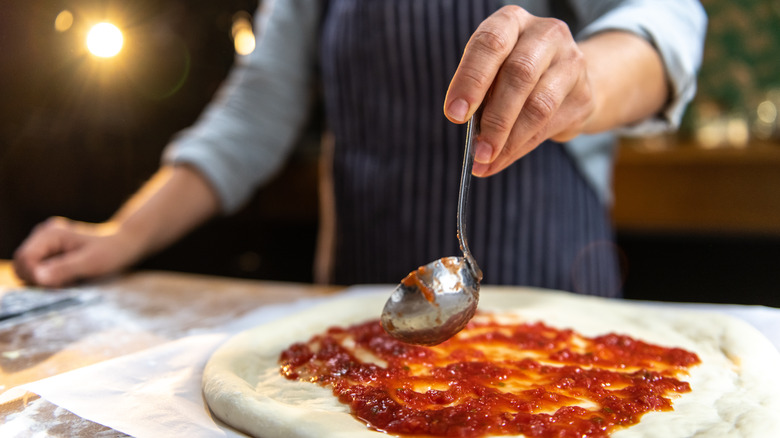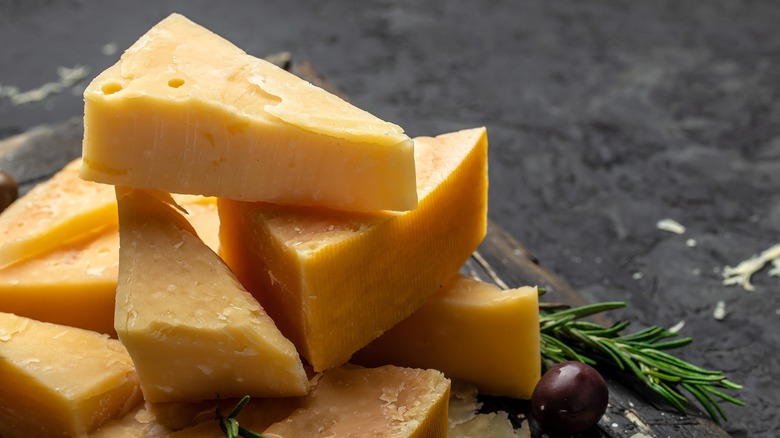Parmesan Is The Key Ingredient In The Best Pizza Sauce
Whether you like it to-go from Domino's or cooked Neopolitan-style in a brick oven, pizza is one of the most crowd-pleasing dishes of all time. From veggie-filled pies to meat lover's feasts, there's no wrong way to enjoy it, but one element is often overlooked in: the sauce. Pizza sauce isn't just a bed for cheese and toppings — it's a vehicle for any sort of flavor that would complement your pie, and a canvas for culinary creativity. A zesty tomato sauce is traditional, as it cuts through and enlivens the rich cheese on your pie, but have you ever considered putting cheese inside the sauce, as well?
A sprinkle of aged Parmesan cheese just might be the key to bettering any pizza sauce. It's naturally high in umami (savoriness), and adds a layer of depth and richness to any sauce, jazzing up the overall flavor of the pizza. Thanks to its subtle yet nuanced tapestry of flavors, a good Parmesan gives your pizza sauce decadent notes of nuttiness and saltiness. It also add a creamy quality to the sauce, giving each bite of pizza a silkier and fuller mouthfeel.
Because Parmesan pairs well with a wide range of ingredients, you can incorporate it into both red and white sauces. The cheese itself also comes in a few different varieties, so coming up with Parmesan and sauce pairings is only limited by your creativity.
Types of Parmesan
Before you start mixing Parmesan into your pizza sauce, consider the different variations of this classic Italian cheese. Aged for a minimum of 12 months, but often much longer, authentic Parmigiano-Reggiano is known for its granular texture, intense flavor, and nutty and fruity notes. It is a PDO cheese, meaning it must adhere to specific production standards in order to carry the name. It's more expensive than generic Parmesan in a green plastic shaker, but worth it. Parmigiano-Reggiano is generally sold in a whole block, so you'll have to grate it by hand into your pizza sauce.
This isn't to say that similar cheeses are anything to sneeze at. If you can't find or afford Parmigiano-Reggiano, don't fret — just put in a bit more effort to find the next best thing. Parmigiano-Reggiano-style cheeses made outside of Italy are what we commonly know as Parmesan. Generic Parmesan cheeses come from various countries around the world, and are produced to mimic the characteristics of the original, without adhering to the strict standards of the PDO designation.
Parmesan cheese still gives your pizza sauce a nutty, savory, and salty flavor that will take your pies from ordinary to extraordinary. You'll just have to do some research to separate insipid brands from the good stuff. Parmesan is either sold pre-grated or in a block, and the pre-grated stuff obviously saves you prep work, so make the choice that sounds good to you.
Complementary toppings
Now that you're a Parmesan expert and have bought some good stuff, let's get into some unique pizza toppings that will complement your Parm-kissed sauce. Prosciutto, with its salty and meaty flavor profile, provides a savory complement to the nutty Parmesan. Paired with the peppery freshness of arugula to cut through the richness, this trio of toppings culminates in rich layers of flavor and a diverse tapestry of textures.
On the other hand, caramelized onions invite a sweet allium essence that complements a savory Parmesan-infused sauce. When combined with creamy, zesty Gorgonzola cheese, your pizza will boast the perfect balance of sweet and tangy.
For something even more sophisticated, turn to fruit. The warm essence of figs are bolstered by the salty quality of Parmesan, and when drizzled with a balsamic glaze, your pizza will walk the line between sweet, savory, and acidic. Remember that you don't have to stick to classic tomato-based sauces, either. Let your imagination run wild, because as long you have Parmesan on hand, your pizza sauce knows no boundaries.


